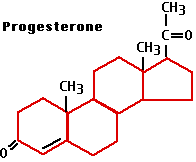| Index to this page |

Progesterone is one of the steroid hormones.
It is secreted by the corpus luteum and by the placenta and is responsible for preparing the body for pregnancy and, if pregnancy occurs, maintaining it until birth.
If pregnancy does occur, the placenta begins to secrete progesterone which supplements that of the corpus luteum. In fact, by the fifth month of pregnancy, the placenta secretes sufficient progesterone by itself that the corpus luteum is no longer essential to maintain pregnancy.
The progesterone response element is a specific sequence of DNA in the promoters of certain genes that is needed to turn those genes on (or off). Thus, the complex of progesterone with its receptor forms a transcription factor.
| Some target cells also have other progesterone receptors that are exposed at the surface of the cell embedded in the plasma membrane. These are G-protein-coupled receptors, and binding of the hormone to them produces more rapid effects than those of the nuclear receptors. |
RU486 (also known as mifepristone) is a synthetic steroid related to progesterone.
Unlike the progestins discussed above, that mimic the action of progesterone, RU-486 blocks the action of progesterone.
(Synthetic molecules that mimic the action of a natural molecule are called agonists; those that oppose it are antagonists.)
RU-486 is a progesterone antagonist. It binds to the progesterone receptor, and in so doing prevents progesterone itself from occupying its receptor. Thus the gene transcription normally turned on by progesterone is blocked, and the proteins necessary to begin and maintain pregnancy are not synthesized.
If RU-486 is taken shortly after intercourse, it prevents pregnancy. If taken early in pregnancy, it causes the embryo to be aborted.
This result has caused RU-486 to be widely used in Europe to terminate early pregnancy. It has not found widespread acceptance in the U.S.
| Welcome&Next Search |